New Percutaneous Approaches for the Treatment of Heavily Calcified Mitral Valve Stenosis
Abstract
1. Introduction
2. Traditional Percutaneous Approach for Mitral Stenosis
3. Lithotripsy-Facilitated Percutaneous Mitral
3.1. Commissurotomy
3.2. Valve in Mitral Annular Calcifications (“Valve-in-MAC”)
- (a)
- Paravalvular leakage (PVL) since the mitral annulus is not circular but D-shaped. This complication can be avoided by prosthesis over-sizing;
- (b)
- Bioprosthesis embolization, in cases of non-complete circumferential MAC;
- (c)
- Obstruction of the LV outflow tract (LVOT) due to displacement of the anterior leaflet of the mitral valve. This event carries higher mortality rates, is more frequent in ViMAC than in ViV or ViR, can be anticipated with precise imaging-based preprocedural planning (CT), and may be solved with midline lacerations of the anterior leaflet (laceration of the anterior mitral leaflet to prevent Outflow obstruction during TMVR: LAMPOON technique) [14] or by means of alcohol septal ablation (ASA) if coronary anatomy is suitable [15];
- (d)
- Similar surgical treatments, valvular mismatch, or the impossibility to implant any available prosthesis in very large mitral annuli.
4. Future Directions
- (a)
- In MITRAL II (NCT04408430), a prospective non-randomized multicenter trial, 110 patients will be treated with ViMAC (SAPIEN 3 and SAPIEN 3 Ultra), and 100 patients not suitable for ViMAC will be treated with optimal medical treatment and will serve as controls.
- (b)
- In SITRAL (NCT02830204), 30 patients at a high risk for mitral valve surgery or deemed inoperable due to the extent of calcification will be treated with surgical SAPIEN 3 valve implantation.
5. Conclusions
Author Contributions
Funding
Institutional Review Board Statement
Informed Consent Statement
Data Availability Statement
Acknowledgments
Conflicts of Interest
References
- Vahanian, A.; Beyersdorf, F.; Praz, F.; Milojevic, M.; Baldus, S.; Bauersachs, J.; Capodanno, D.; Conradi, L.; De Bonis, M.; De Paulis, R.; et al. 2021 ESC/EACTS Guidelines for the management of valvular heart disease: Developed by the Task Force for the management of valvular heart disease of the European Society of Cardiology and the European Association for Cardio-Thoracic Surgery. Eur. Heart J. 2022, 43, 561–632. [Google Scholar] [CrossRef] [PubMed]
- McInerney, A.; Marroquin-Donday, L.; Tirado-Conte, G.; Hennessey, B.; Espejo, C.; Pozo, E.; de Agustín, A.; Gonzalo, N.; Salinas, P.; Núñez-Gil, I.; et al. Transcatheter Treatment of Mitral Regurgitation. J. Clin. Med. 2022, 11, 2921. [Google Scholar] [CrossRef] [PubMed]
- Inoue, K.; Owaki, T.; Nakamura, T.; Kitamura, F.; Miyamoto, N. Clinical application of transvenous mitral commissurotomy by a new balloon catheter. J. Thorac. Cardiovasc. Surg. 1984, 87, 394–402. [Google Scholar] [CrossRef]
- Iung, B.; Nicoud-Houel, A.; Fondard, O.; Akoudad, H.; Haghighat, T.; Brochet, E.; Garbarz, E.; Cormier, B.; Baron, G.; Luxereau, P.; et al. Temporal trends in percutaneous mitral commissurotomy over a 15-year period. Eur. Heart J. 2004, 25, 701–707. [Google Scholar] [CrossRef]
- Nowak, B.; Baykut, D.; Kaltenbach, M.; Reifart, N. Usefulness of shock wave lithotripsy as pretreatment for balloon valvuloplasty in calcified mitral stenosis. Am. J. Cardiol. 1989, 63, 996–997. [Google Scholar] [CrossRef]
- Forero, M.N.T.; Daemen, J. The Coronary Intravascular Lithotripsy System. Interv. Cardiol. 2019, 14, 174–181. [Google Scholar]
- Kassimis, G.; Didagelos, M.; De Maria, G.L.; Kontogiannis, N.; Karamasis, G.V.; Katsikis, A.; Sularz, A.; Karvounis, H.; Kanonidis, I.; Krokidis, M.; et al. Shockwave Intravascular Lithotripsy for the Treatment of Severe Vascular Calcification. Angiology 2020, 71, 677–688. [Google Scholar] [CrossRef]
- Eng, M.H.; Villablanca, P.; Wang, D.D.; Frisoli, T.; Lee, J.; O’Neill, W.W. Lithotripsy-Facilitated Mitral Balloon Valvuloplasty for Senile Degenerative Mitral Valve Stenosis. JACC Cardiovasc. Interv. 2019, 12, e133–e134. [Google Scholar] [CrossRef]
- Sharma, A.; Kelly, R.; Mbai, M.; Chandrashekhar, Y.; Bertog, S. Transcatheter Mitral Valve Lithotripsy as a Pretreatment to Percutaneous Balloon Mitral Valvuloplasty for Heavily Calcified Rheumatic Mitral Stenosis. Circ. Cardiovasc. Interv. 2020, 13, e009357. [Google Scholar] [CrossRef]
- Sanz-Ruiz, R.; González-Mansilla, A.; Rivera-Juárez, A.; Bermejo, J.; Fernández-Avilés, F. 1-Step Percutaneous Treatment of Heavily Calcified Left-Heart Valve Stenoses. JACC Cardiovasc. Interv. 2021, 14, e335–e337. [Google Scholar] [CrossRef]
- Holtz, J.E.; Upadhyaya, D.S.; Cohen, B.E.; Na, B.; Schiller, N.B.; Whooley, M.A. Mitral annular calcium, inducible myocardial ischemia, and cardiovascular events in outpatients with coronary heart disease (from the Heart and Soul Study). Am. J. Cardiol. 2012, 109, 1092–1096. [Google Scholar] [CrossRef] [PubMed]
- Chehab, O.; Roberts-Thomson, R.; Bivona, A.; Gill, H.; Patterson, T.; Pursnani, A.; Grigoryan, K.; Vargas, B.; Bokhary, U.; Blauth, C.; et al. Management of Patients with Severe Mitral Annular Calcification. J. Am. Coll. Cardiol. 2022, 80, 722–738. [Google Scholar] [CrossRef] [PubMed]
- Cheng, R. How to Manage Mitral Stenosis Due to Mitral Annular Calcification. Curr. Cardiol. Rep. 2021, 23, 148. [Google Scholar] [CrossRef] [PubMed]
- Khan, J.M.; Babaliaros, V.C.; Greenbaum, A.B.; Foerst, J.R.; Yazdani, S.; McCabe, J.M.; Paone, G.; Eng, M.H.; Leshnower, B.G.; Gleason, P.T.; et al. Anterior Leaflet Laceration to Prevent Ventricular Outflow Tract Obstruction During Transcatheter Mitral Valve Replacement. J. Am. Coll. Cardiol. 2019, 73, 2521–2534. [Google Scholar] [CrossRef]
- Wang, D.D.; Guerrero, M.; Eng, M.H.; Eleid, M.F.; Meduri, C.U.; Rajagopal, V.; Yadav, P.K.; Fifer, M.A.; Palacios, I.F.; Rihal, C.S.; et al. Alcohol septal ablation to prevent left ventricular outflow tract obstruction during transcatheter mitral valve replacement: First-in-man study. JACC Cardiovasc. Interv. 2019, 12, 1268–1279. [Google Scholar] [CrossRef]
- Hamid, U.I.; Gregg, A.; Ball, P.; Owens, C.; Manoharan, G.; Spence, M.S.; Jeganathan, R. Open transcatheter valve implantation for mitral annular calcification: One-year outcomes. JTCVS Tech. 2021, 10, 254–261. [Google Scholar] [CrossRef] [PubMed]
- Eleid, M.F.; Whisenant, B.K.; Cabalka, A.K.; Williams, M.R.; Nejjari, M.; Attias, D.; Fam, N.; Amoroso, N.; Foley, T.A.; Pollak, P.M.; et al. Early outcomes of percutaneous transvenous transseptal transcatheter valve implantation in failed bioprosthetic mitral valves, ring annuloplasty, and severe mitral annular calcification. JACC Cardiovasc. Interv. 2017, 10, 1932–1942. [Google Scholar] [CrossRef]
- Guerrero, M.; Urena, M.; Himbert, D.; Wang, D.D.; Eleid, M.; Kodali, S.; George, I.; Chakravarty, T.; Mathur, M.; Holzhey, D.; et al. 1-Year Outcomes of Transcatheter Mitral Valve Replacement in Patients with Severe Mitral Annular Calcification. J. Am. Coll. Cardiol. 2018, 71, 1841–1853. [Google Scholar] [CrossRef]
- Yoon, S.-H.; Whisenant, B.K.; Bleiziffer, S.; Delgado, V.; Dhoble, A.; Schofer, N.; Eschenbach, L.; Bansal, E.; Murdoch, D.J.; Ancona, M.; et al. Outcomes of transcatheter mitral valve replacement for degenerated bioprostheses, failed annuloplasty rings, and mitral annular calcification. Eur. Heart J. 2019, 40, 441–451. [Google Scholar] [CrossRef]
- Tiwana, J.; Aldea, G.; Levin, D.B.; Johnson, K.; Don, C.W.; Dvir, D.; Mackensen, G.B.; Reisman, M.; McCabe, J.M. Contemporary transcatheter mitral valve replacement for mitral annular calcification or ring. JACC Cardiovasc. Interv. 2020, 13, 2388–2398. [Google Scholar] [CrossRef]
- Eng, M.H.; Kargoli, F.; Wang, D.D.; Frisoli, T.M.; Lee, J.C.; Villablanca, P.S.; Nemeh, H.; Greenbaum, A.B.; Guerrero, M.; O’Neill, B.P.; et al. Short- and mid-term outcomes in percutaneous mitral valve replacement using balloon expandable valves. Catheter. Cardiovasc. Interv. 2021, 98, 1193–1203. [Google Scholar] [CrossRef] [PubMed]
- Guariento, A.; Fiocco, A.; Vida, V. Commentary: A transcatheter challenge: Can you deploy a valve into a Big Mac? JTCVS Tech. 2021, 10, 262–263. [Google Scholar] [CrossRef]
- Formica, F. Commentary: From bailout to standardized approach in mitral annulus calcification: It’s a short step. JTCVS Tech. 2021, 10, 264–265. [Google Scholar] [CrossRef] [PubMed]
- Fam, N.P.; Hagemeyer, D.; Merdad, A.; Bisleri, G.; Ong, G. Transcatheter edge-to-edge repair of severe calcific mitral regurgitation facilitated by balloon lithotripsy. EuroIntervention 2022, 17, 1532–1533. [Google Scholar] [CrossRef] [PubMed]

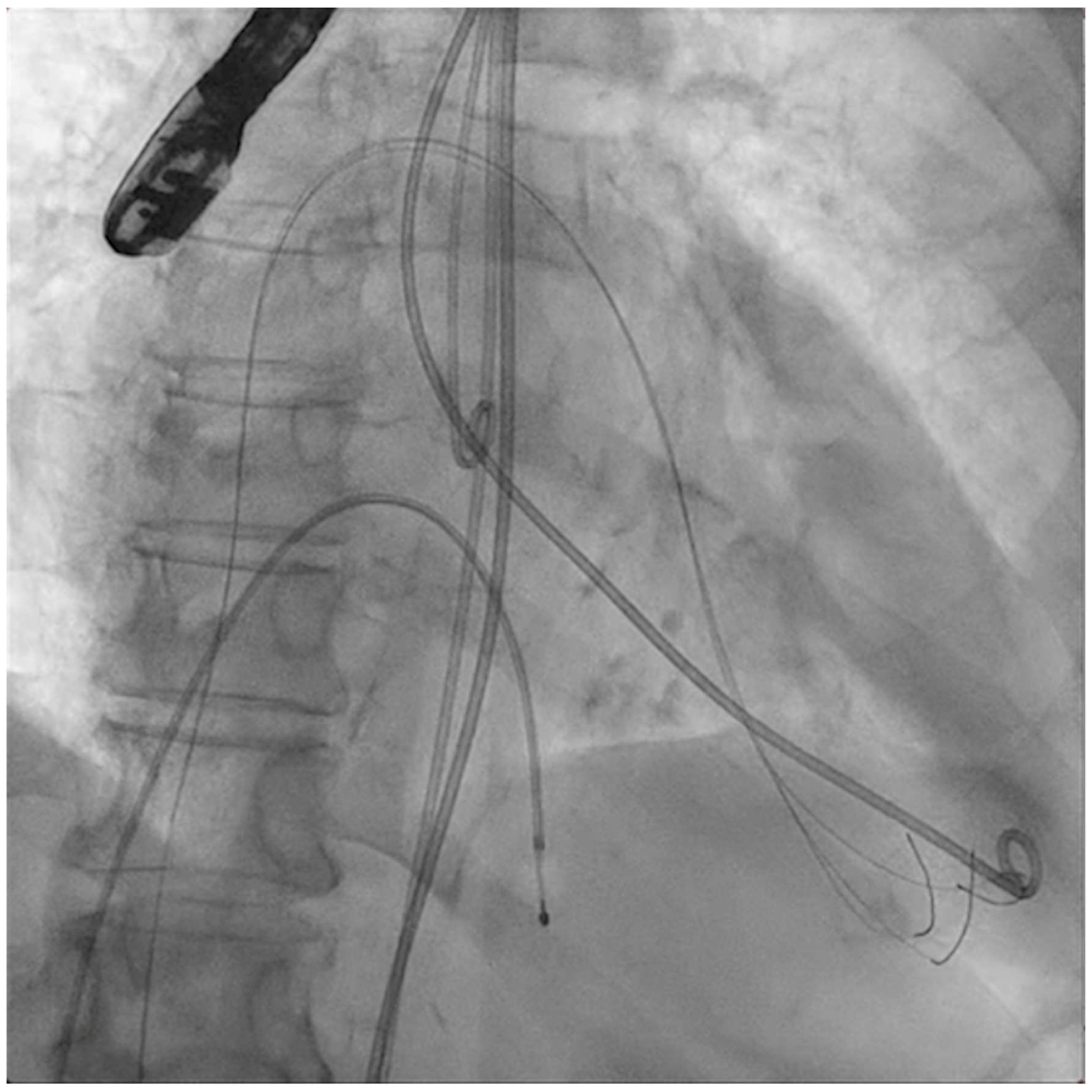
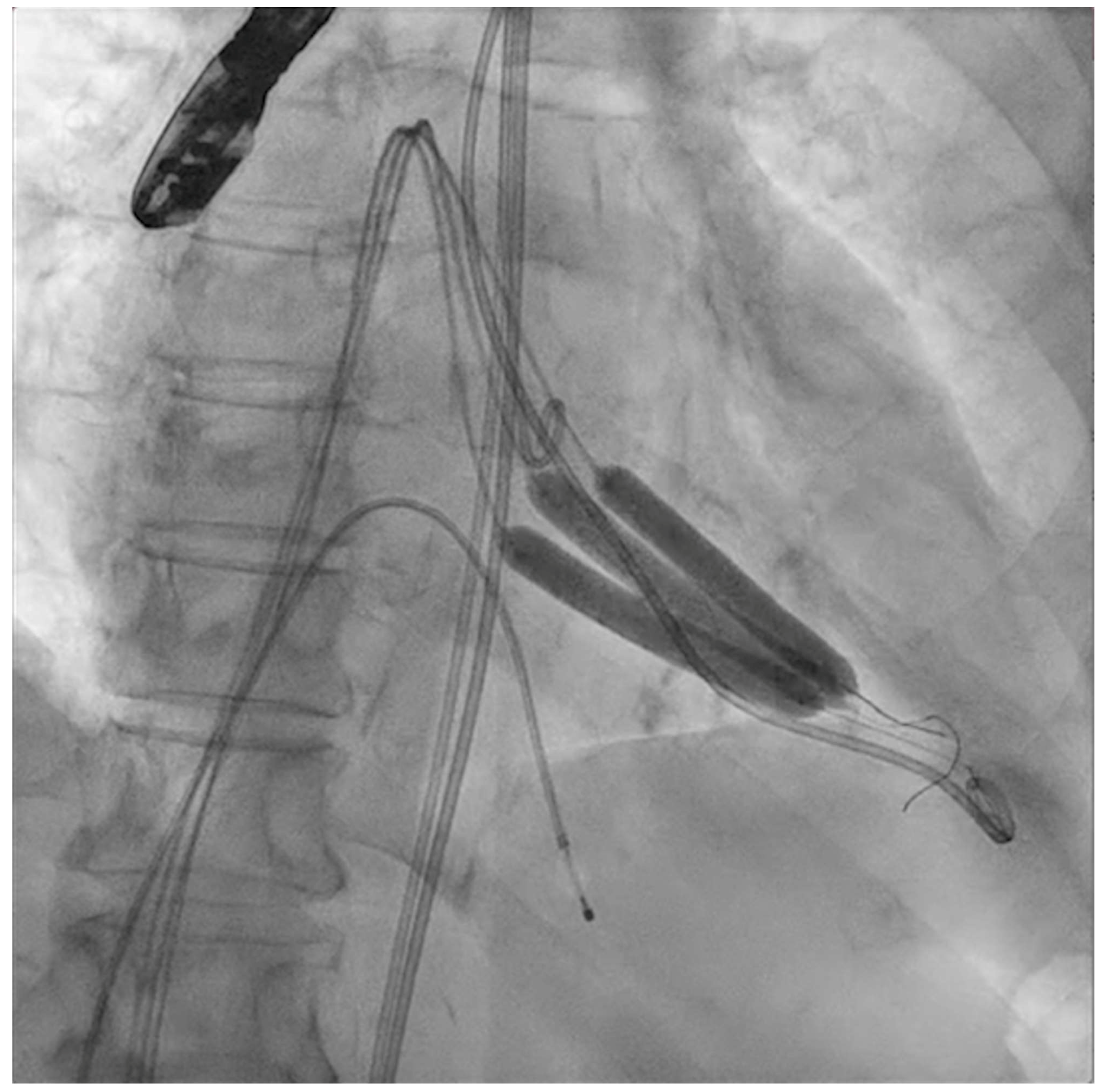
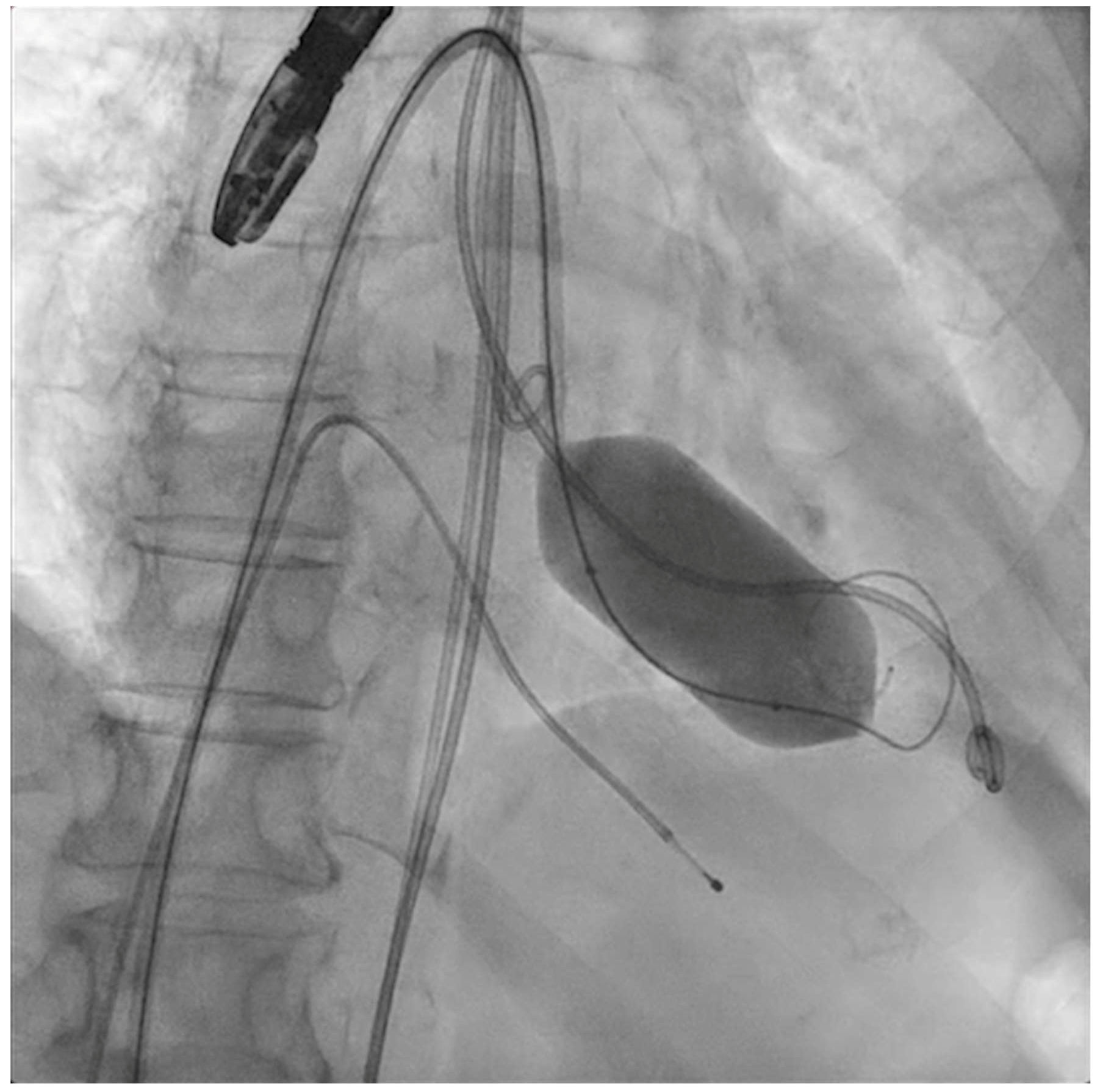
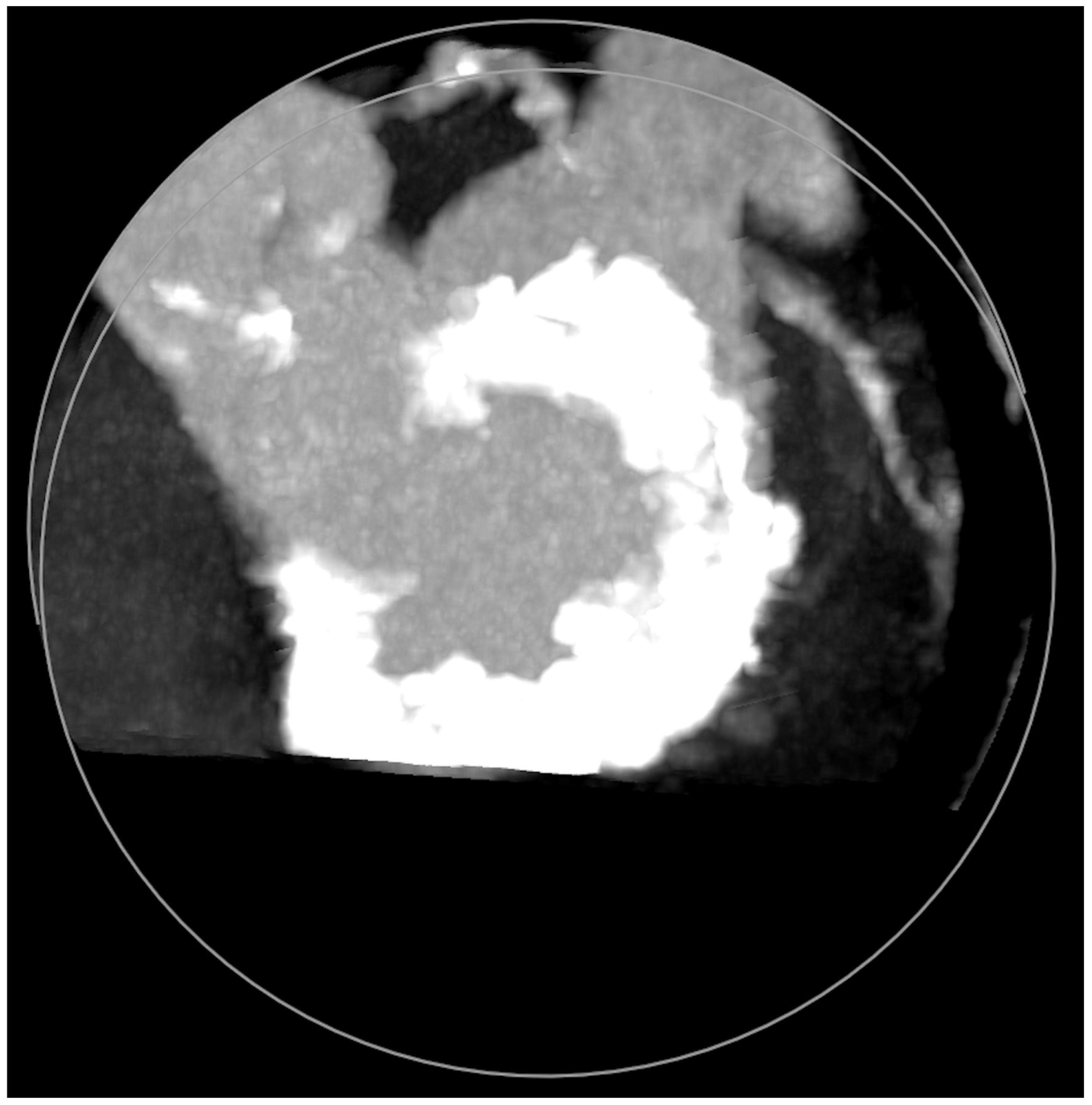
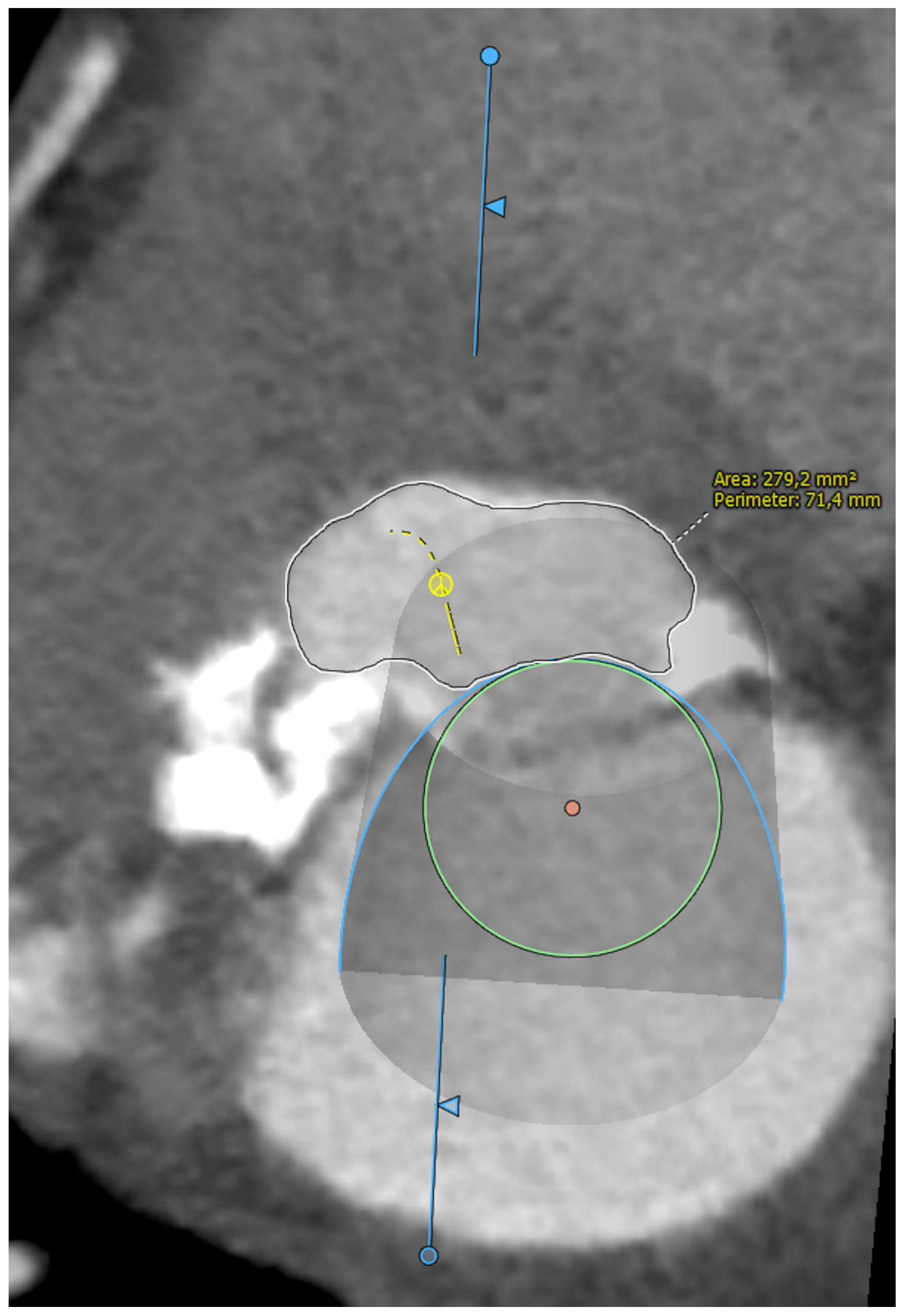
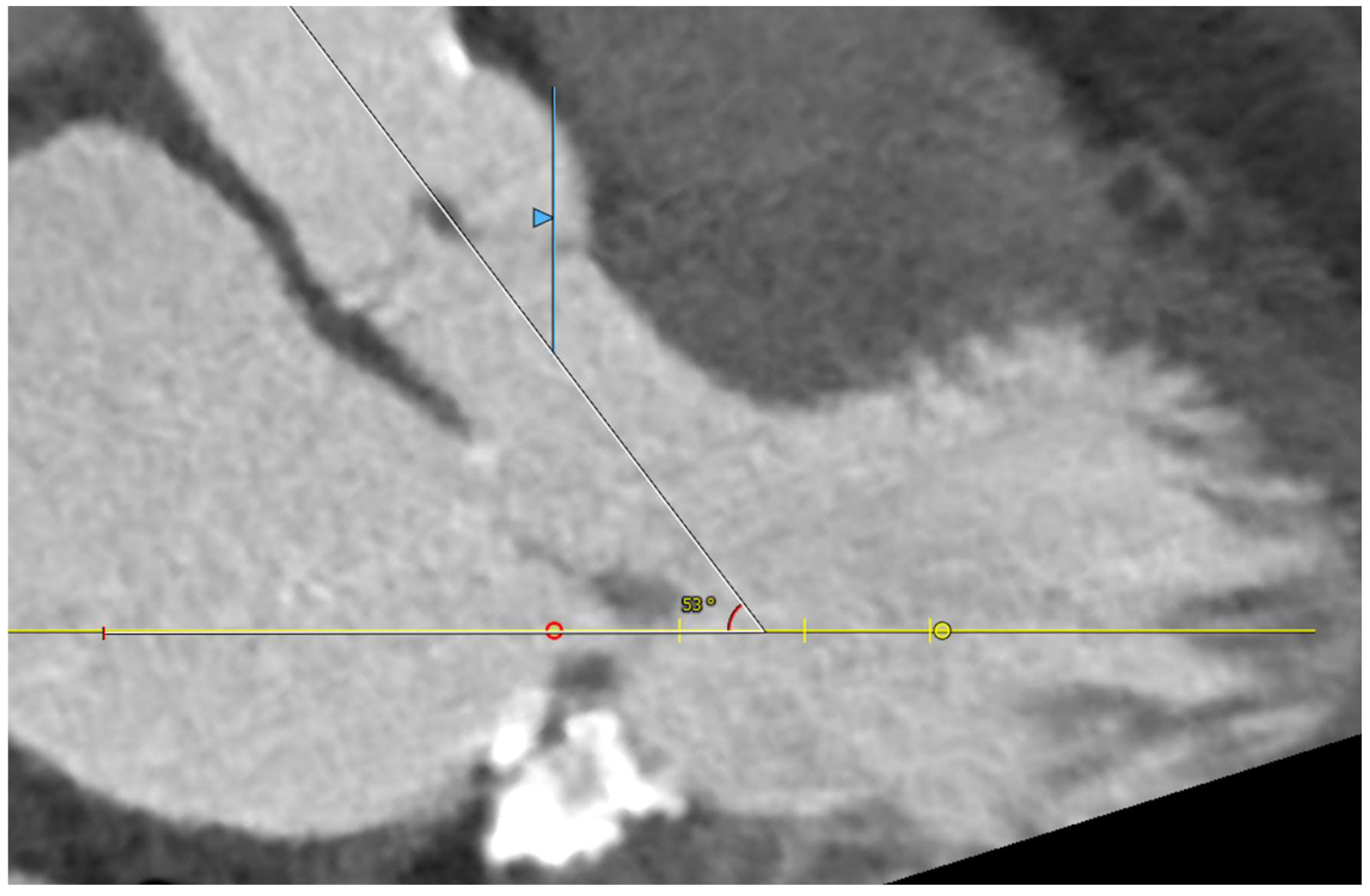
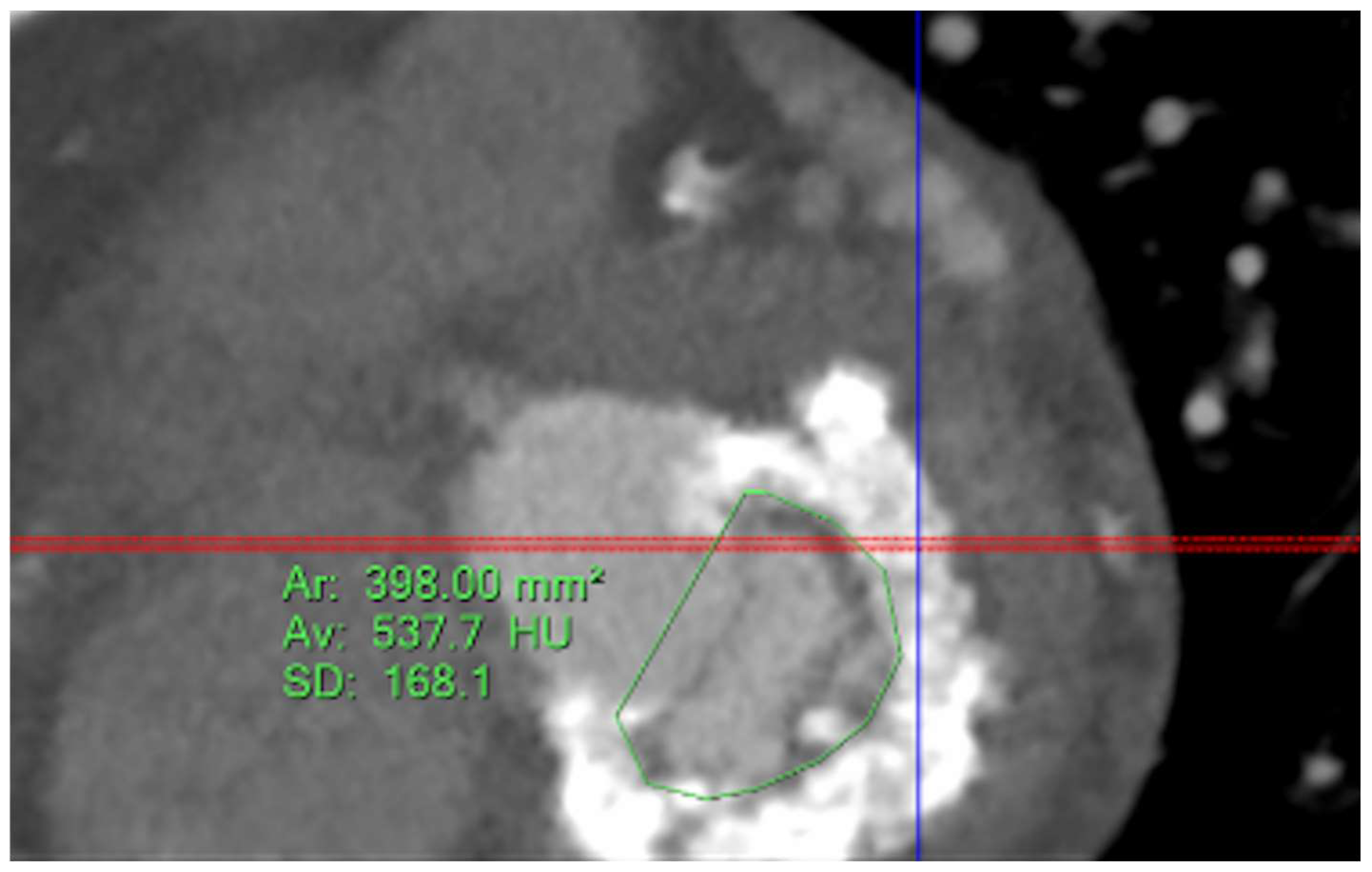
| Study | n | Design | Type of Valve | Transseptal Approach * | Technical Success ** | Outcome | Follow-up | Results |
|---|---|---|---|---|---|---|---|---|
| Eleid 2017 [17] | 12 (ViMAC arm) | Retrospective multicenter registry | Edwards SAPIEN (100%) | 97% | 75% | Death or cardiac surgery | 30 days−1 year | 22−32% |
| Guerrero 2018 [18] | 106 | Retrospective multicenter registry | Edwards SAPIEN (98%), Inovare (2%) | 41% | 77% | All-cause mortality | 3 months−1 year | 25−54% |
| Yoon 2019 [19] | 58 (ViMAC arm) | Prospective multicenter registry | Edwards SAPIEN (81%), Lotus (16%), Direct Flow (3%) | 53% | 62% | All-cause mortality | 3 months−1 year | 35−63% |
| Tiwana 2020 [20] | 28 (ViMAC arm) | Retrospective single-center registry | Edwards SAPIEN (100%) | 86% | 57% | All-cause mortality | 30 days | 21% |
| Eng 2021 [21] | 19 (ViMAC arm) | Prospective single-center registry | Edwards SAPIEN (100%) | 95% | 63% | All-cause mortality | 1 year | 58% |
Publisher’s Note: MDPI stays neutral with regard to jurisdictional claims in published maps and institutional affiliations. |
© 2022 by the authors. Licensee MDPI, Basel, Switzerland. This article is an open access article distributed under the terms and conditions of the Creative Commons Attribution (CC BY) license (https://creativecommons.org/licenses/by/4.0/).
Share and Cite
Sanz-Ruiz, R.; Vázquez-Álvarez, M.E.; Gutiérrez-Ibañes, E.; Díez-delHoyo, F.; Tamargo-Delpon, M.; García-Carreño, J.; Soriano-Trigueros, J.; Elízaga-Corrales, J.; Fernández-Avilés, F. New Percutaneous Approaches for the Treatment of Heavily Calcified Mitral Valve Stenosis. J. Clin. Med. 2022, 11, 6444. https://doi.org/10.3390/jcm11216444
Sanz-Ruiz R, Vázquez-Álvarez ME, Gutiérrez-Ibañes E, Díez-delHoyo F, Tamargo-Delpon M, García-Carreño J, Soriano-Trigueros J, Elízaga-Corrales J, Fernández-Avilés F. New Percutaneous Approaches for the Treatment of Heavily Calcified Mitral Valve Stenosis. Journal of Clinical Medicine. 2022; 11(21):6444. https://doi.org/10.3390/jcm11216444
Chicago/Turabian StyleSanz-Ruiz, Ricardo, María Eugenia Vázquez-Álvarez, Enrique Gutiérrez-Ibañes, Felipe Díez-delHoyo, María Tamargo-Delpon, Jorge García-Carreño, Javier Soriano-Trigueros, Jaime Elízaga-Corrales, and Francisco Fernández-Avilés. 2022. "New Percutaneous Approaches for the Treatment of Heavily Calcified Mitral Valve Stenosis" Journal of Clinical Medicine 11, no. 21: 6444. https://doi.org/10.3390/jcm11216444
APA StyleSanz-Ruiz, R., Vázquez-Álvarez, M. E., Gutiérrez-Ibañes, E., Díez-delHoyo, F., Tamargo-Delpon, M., García-Carreño, J., Soriano-Trigueros, J., Elízaga-Corrales, J., & Fernández-Avilés, F. (2022). New Percutaneous Approaches for the Treatment of Heavily Calcified Mitral Valve Stenosis. Journal of Clinical Medicine, 11(21), 6444. https://doi.org/10.3390/jcm11216444





